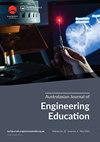Making whiteness visible: The promise of critical race theory in engineering education
Q1 Social Sciences
引用次数: 7
Abstract
In the summer of 2020, the United States erupted in a series of protests designed to confront this nation's problem with race. As conversations about racial justice took hold in the public sphere, attention was drawn to critical race theory (CRT) and what role it might have in explaining why the United States remains rooted in racism. However, on September 4, 2020, Office of Management and Budget (OMB) director Russell Vought sent a letter mischaracterizing CRT that subsequently incited a crusade of disinformation and misguided rage (Cineas, 2020). The ensuing fallout has led to an educational crisis as educators grow fearful of teaching the United States' history comprehensively (Griesbach, 2021; Herman, 2021). Rather than critically evaluate how the systems (e.g., educational, judicial, political) within the United States reinforce White supremacist ideology, the focus shifted toward the very theories used to understand this phenomenon. What had the potential to be a racial reckoning instead became an attack on CRT. Across the United States, politicians, school boards, colleges, and universities attempted to ban and eliminate CRT (or topics associated with it) from discussion. While critics of CRT framed their opposition as an attempt to decrease racism by not giving it any attention, the pushback against this theory actually reflects a hard truth: that the historical accuracy CRT demands is an existential threat to White supremacy. Trying to censor theories of race is an example of the very thing CRT highlights—that systems are designed to reinforce whiteness—and legislating the erasure of CRT is one form of this White supremacy. We want to make clear that those in strong opposition to CRT are not the primary audience for this editorial. This editorial is for those who want to do better in calling out the role of whiteness in their research that employs a CRT framework. We start with contextualizing the relevance of CRT, then provide a brief overview of it as a theorizing space (as opposed to a theoretical framework), discuss it within engineering education research (EER), and conclude with questions scholars engaging with this theory should consider as they move forward. In this Year of Impact on Racial Equity, the EER community would do well to scrutinize the recent, and ongoing, campaign against CRT taking hold in various educational spaces (American Society for Engineering Education [ASEE], n.d.). The ASEE has endorsed this yearlong effort “to help leverage and extend the societal momentum toward greater awareness and action to dismantle white supremacy and racism” at a time when White supremacy is flexing its political and social muscle (ASEE, n.d.). This type of attention is particularly important as mention of CRT grows within EER. While some scholars have mentioned it as a useful theory in understanding the experiences of racially excluded people in EER (e.g., DeCuir-Gunby et al., 2009; Ong et al., 2020; Trytten et al., 2013), others have suggested that the use of frameworks like CRT in this domain has largely characterized racially excluded students from a deficit perspective (Mejia et al., 2018). In noticing this trend, we ask, how can EER best apply CRT? Despite the wide range of scholarship on CRT, both the public discourse and many of the published papers mentioning it in engineering make clear that this theory is misunderstood. Too often CRT discussions involve only two of its primary tenets: (1) racism is endemic and (2) the centrality of experiential knowledge. However, these tenets do not directly name a critical component for understanding race in the United States. Any use of CRT within the EER community should center whiteness. This is the only way to make any significant progress on actualizing racial equity and confronting the ways White supremacy operates within engineering classrooms. In 1998, Gloria Ladson-Billings asked, “Just what is critical race theory and what's it doing in a nice field like education?” (p. 7). That question set forth several decades of scholarship that explored the relationship between CRT and让白人可见:批判种族理论在工程教育中的前景
2020年夏天,美国爆发了一系列抗议活动,旨在应对这个国家的种族问题。随着有关种族正义的讨论在公共领域占据主导地位,人们的注意力被吸引到批判种族理论(CRT)上,以及它在解释为什么美国仍然植根于种族主义方面可能发挥的作用。然而,在2020年9月4日,美国管理和预算办公室(OMB)主任拉塞尔·沃特(Russell Vought)发出了一封错误描述CRT的信,随后引发了一场虚假信息和误导愤怒的运动。(见注39)随之而来的后果导致了一场教育危机,因为教育工作者越来越害怕全面教授美国历史(Griesbach, 2021;赫尔曼,2021)。而不是批判性地评估系统(例如,教育,司法,政治)如何在美国加强白人至上主义的意识形态,重点转移到理论用来理解这一现象。有可能成为种族清算的事情反而变成了对CRT的攻击。在整个美国,政治家、学校董事会、学院和大学都试图禁止和消除CRT(或与之相关的话题)的讨论。虽然CRT的批评者认为他们的反对是试图通过不给予任何关注来减少种族主义,但对这一理论的反击实际上反映了一个残酷的事实:CRT要求的历史准确性是对白人至上主义的生存威胁。试图审查种族理论正是CRT强调的事情的一个例子-系统旨在加强白人-立法删除CRT是这种白人至上主义的一种形式。我们想要明确的是,那些强烈反对CRT的人并不是这篇社论的主要读者。这篇社论是写给那些想在使用CRT框架的研究中更好地指出白人角色的人的。我们首先将CRT的相关性置于背景中,然后将其作为一个理论化空间(而不是理论框架)进行简要概述,在工程教育研究(EER)中讨论它,并总结参与该理论的学者在前进时应该考虑的问题。在今年的种族平等影响年,EER社区应该好好审视最近和正在进行的反对CRT在各个教育领域占据主导地位的运动(美国工程教育协会[ASEE], n.d)。在白人至上主义正在展示其政治和社会力量的时候,ASEE已经批准了这项为期一年的努力,“帮助利用和扩大社会动力,提高意识和行动,以拆除白人至上主义和种族主义”(ASEE, n.d)。这种类型的关注尤其重要,因为在EER中提到CRT。虽然一些学者认为这是一个有用的理论,可以理解EER中被种族排斥的人的经历(例如,DeCuir-Gunby等人,2009;Ong等人,2020;Trytten et al., 2013),其他人则认为,从缺陷的角度来看,在这一领域使用像CRT这样的框架在很大程度上是种族排斥学生的特征(Mejia et al., 2018)。在注意到这一趋势后,我们问,EER如何最好地应用CRT?尽管关于CRT的学术研究范围很广,但公共话语和许多在工程领域提到它的发表论文都清楚地表明,这一理论被误解了。CRT的讨论常常只涉及两个主要原则:(1)种族主义是地方性的;(2)经验知识的中心地位。然而,这些原则并没有直接指出理解美国种族的一个关键因素。在EER社区中,CRT的任何使用都应该以白色为中心。这是在实现种族平等和对抗白人至上主义在工程课堂上运作的方式方面取得重大进展的唯一途径。1998年,格洛丽亚·拉森-比林斯(Gloria Ladson-Billings)问道:“什么是批判种族理论?它在教育这样的好领域有什么用?”(第7页)。这个问题引发了几十年的学术研究,探讨了CRT和
本文章由计算机程序翻译,如有差异,请以英文原文为准。
求助全文
约1分钟内获得全文
求助全文
来源期刊

Australasian Journal of Engineering Education
Social Sciences-Education
CiteScore
6.40
自引率
0.00%
发文量
8
 求助内容:
求助内容: 应助结果提醒方式:
应助结果提醒方式:


